Do you have a problem with telling time in Korean?
Well, who doesn’t?
Telling time in Korean can be confusing, very confusing & frustrating at first (especially to an English speaker).
Because it’s not just about reading a clock. You have to use both Korean Number systems at the same time and memorize a lot of related words.
But Why should you even bother?
Because time is everything. Fixing a coffee time with friends or a date night? Got a bus to catch? Or just asking “What time is it” in Korean? You will need a small talk about time for that.
Like it or not, our life is dictated by time. So let’s not miss those small talks and learn how to talk about time in many ways.
And the best part?
This step-by-step guide will help you tell any time in Korean with examples, cheatsheets, Flashcards(Printable), PDF, and exercises to make sure the words roll right off your tongue like a native.
All right, world, let’s dig in (to the core)…
Table of Contents
How To Say TIME In Korean (Step-By-Step)?: Learn Korean Time Format
The Korean word for time is 시간 (sigan) but Korean also use 시 (si). Here’s the order to tell time in Korean: First indicate the am or pm, the hour, and then the minutes/seconds. (시) si is a counter used for hours with native Korean numbers and for minutes, just use Sino-Korean numbers with the counter 분 (bun).

The counting word for hours is 시, the counting word for minutes is 분 and the counting word for seconds is 초.
Before you know how to ask and tell the time in Korean, it is a good idea to know all the numbers in Korean correctly.
Imagine what blunders can wrong numbers make when you are speaking the correct phrase like an expert but with feeling sorry for your mistake
Here’s the exact structure to tell time in Korean language
AM(오전[ojeon])+ Hours(Sino-Korean) +(시) si + minutes (sino-Korean) + 분 (bun)
Let me explain with examples
We simply combine the two to say the time. Here are some examples:
- 1:30 – 한시 삼십분. (han-si samsib-bun)-The Korean native number for 1 + 시 + the Sino-Korean number for 30 + 분, we get: One-thirty.
- 6:55 -would be 여섯시 오십오분. (yeoseot-si osibo-bun)
- The Korean native number for 6 + 시 + the Sino-Korean number for 55 + 분, we get: Six-fifty-five.
- 12:15 – 열두시 십오분. (yeoldu-si sibo-bun)
- The Korean native number for 12 + 시 + the Sino-Korean number for 15 + 분
In English, we say time first and then use am/pm but Koreans prefer to use am/pm first followed by hours, and minutes.
But first things first.
So, how about we take a look at the list of 16 Korean words related to time?
| ENGLISH | Korean(hangul) | ROMANIZATION |
| Time | 시간 | sigan |
| Clock | 시계 | sigye |
| Hour/O’clock | 시 | si |
| Minute | 분 | bun |
| Second | 초 | cho |
| A.M. | 오전 | ojeon |
| P.M. | 오후 | ohu |
| Clock | 시계 | sigye |
| Moment | 순간 | sungan |
| Wristwatch/Watch | 손목 시계 | sonmog sigye |
| Alarm Clock, Alarm | 자명종 | |
| Digital Clock | 디지털 시계 | dijiteol sigye |
| Wall Clock | 벽시계 | |
| Hour Glass/Sand Glass | 모래 시계 | |
| Grandfather Clock | 진자 시계 | jinja sigye |
| Smart Watch | 스마트 워치 | seumateu wochi |
| Time Period/Period/Duration | 기간 | gigan |
| Hour Hand | 시침 | sichim |
| Minute Hand | 분침 | bunchim |
So let’s learn how to tell the time in detail, starting by saying the word for an hour.
The Hours in Korean: How to Tell Time In Korean Using Only Hours
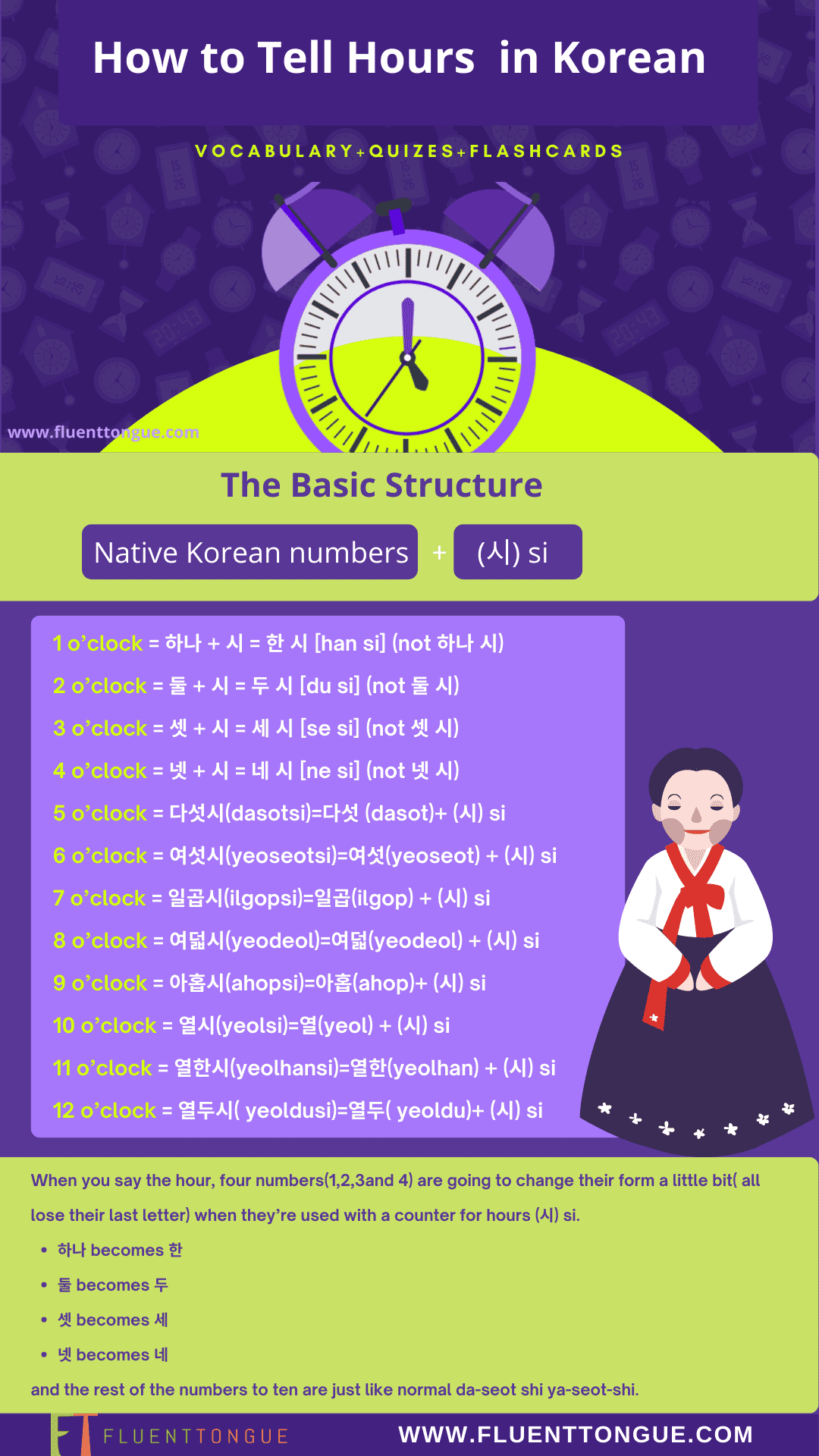
(시) si means “hour” in Korean. You can 시간(Sigan) which also means time.
To tell hours in Korean, you need to use native Korean numbers. All you need to just take the native Korean numbers and put (시) si next to them.
The difference between(시) si and 시간(Sigan) is that (시) si is used for telling time like 6 o’clock and “시간(Sigan)” indicates a quantity of time like 6 hours.
Still not familiar with pure Korean numbers? Don’t worry.
Here’s the monster guide that can help you master it in minutes
Here’s the basic structure to tell hours in Korean
Native Korean numbers +(시) si
Let’s see some examples
- 1 o’clock = 하나 + 시 = 한 시 [han si] (not 하나 시)
- 2 o’clock = 둘 + 시 = 두 시 [du si] (not 둘 시)
- 3 o’clock = 셋 + 시 = 세 시 [se si] (not 셋 시)
- 4 o’clock = 넷 + 시 = 네 시 [ne si] (not 넷 시)
- 5 o’clock = 다섯시(dasotsi)=다섯 (dasot)+ (시) si
- 6 o’clock = 여섯시(yeoseotsi)=여섯(yeoseot) + (시) si
- 7 o’clock = 일곱시(ilgopsi)=일곱(ilgop) + (시) si
- 8 o’clock = 여덟시(yeodeol)=여덟(yeodeol) + (시) si
- 9 o’clock = 아홉시(ahopsi)=아홉(ahop)+ (시) si
- 10 o’clock = 열시(yeolsi)=열(yeol) + (시) si
- 11 o’clock = 열한시(yeolhansi)=열한(yeolhan) + (시) si
- 12 o’clock = 열두시( yeoldusi)=열두( yeoldu)+ (시) si
Did you notice something weird?
When you say the hour, four numbers(1,2,3and 4) are going to change their form a little bit( all lose their last letter) when they’re used with a counter for hours (시) si.
- 하나 becomes 한
- 둘 becomes 두
- 셋 becomes 세
- 넷 becomes 네
and the rest of the numbers to ten are just like normal da-seot shi ya-seot-shi.
Basically, when you are saying how much of something there is you need to use a counter.
Example sentences
- I drink coffee at 9:00.
아홉시에 커피를 마셔요. -ahopssie kopireul masyoyo
- I get up before 7 o’clock every day.
나는 매일 일곱시 전에 일어나요- naneun maeil ilgopssi jone ironayo
- I watch Korean dramas from 9 o’clock to 10 o’clock.
아홉시부터 열시까지 한국 드라마을 봐요.
ahopssibuto yolssikkaji hanguk deuramaeul bwayo
- Can we meet at 8 o’clock?
8시에 만날 수 있어요?-pal sie mannal su issayo
- I don’t think it’s 6 o’clock yet.
아직 여섯시가 안 된 것 같아요.- ajik yosotssiga an dwen got gatayo
- The restaurant doesn’t open until 11 o’clock.
그 식당은 열한시가 되어야 문을 열지 않아요.
geu sikttangeun yolhansiga dweoya muneul yoljji anayo
- I had lunch at 1 o’clock.
한시에 점심을 먹었어요.-hansie jomsimeul mogossoyo
- I eat dinner at 9 o’clock and go home at 10 o’clock.
아홉시에 저녁 식사를 먹고 열시에 집에 가요.
ahopssie jonyok sikssareul mokkko yolssie jibe gayo
The Seconds and Minutes in Korean: How to tell time in Korean Using Seconds & Minutes.
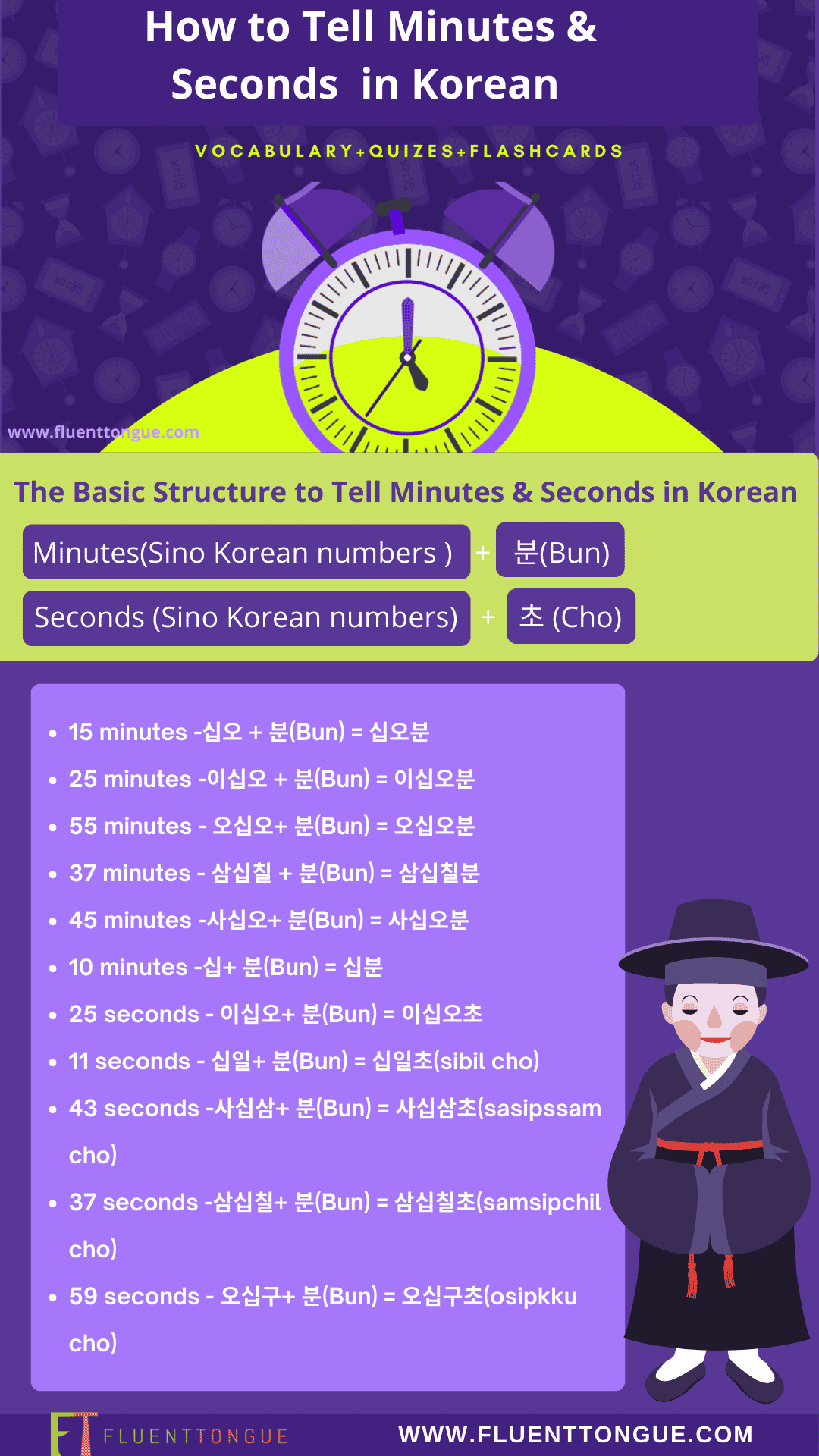
The time is not always on the hour.
So how do you say “half past”, “quarter past” and like 9:34 or 5:30?
It’s time to learn two new words 분(Bun) and 초 (Cho)
Koreans only say hours and minutes to say an exact time. But For times when you need to be more specific, you can use seconds also.
Here’s how
분(Bun) means minutes in Korean and to talk about minutes, you need to use Sino-Korean numbers. All you need to do is just take numbers in Sino Korean and put the counter word ‘분 (boon)’ next to it. For seconds A counter word ‘초 (Cho)” comes after the number in Sino Korean you would like to say.
And you are all set
Here’s the structure to tell minutes in Korean
Minutes(Sino Korean numbers )+ 분(Bun)
The structure to say seconds in Korean
Seconds (Sino Korean numbers) +’초 (Cho)
Let’s take some examples
- 15 minutes -십오 + 분(Bun) = 십오분
- 25 minutes -이십오 + 분(Bun) = 이십오분
- 55 minutes – 오십오+ 분(Bun) = 오십오분
- 37 minutes – 삼십칠 + 분(Bun) = 삼십칠분
- 45 minutes -사십오+ 분(Bun) = 사십오분
- 10 minutes -십+ 분(Bun) = 십분
- 25 seconds – 이십오+ 분(Bun) = 이십오초
- 11 seconds – 십일+ 분(Bun) = 십일초(sibil cho)
- 43 seconds -사십삼+ 분(Bun) = 사십삼초(sasipssam cho)
- 37 seconds -삼십칠+ 분(Bun) = 삼십칠초(samsipchil cho)
- 59 seconds – 오십구+ 분(Bun) = 오십구초(osipkku cho)
Infobox -*Instead of saying 삼십 분 for 30 minutes you can say 반 which means ‘half’. for example, Like to say 12: 30, you can tell to say 1:30 you say
한시 삼십분 or 한시 반
Now let’s put it all together and master telling the exact time in Korean
The structure is
Sino-Korean +시(si) +native Korean + 분 (bun) + Sino-Korean +초 (cho)
Let me explain with examples
- 5:35 – 다섯시삼십오분= 다섯(5) + 시(si)+ 삼십오(35)+ 분(bun)
- 7:15 -일곱시십오분 = 일곱(7) + 시(si)+ 십오(15)+ 분(bun)
- 6:40 – 여섯시사십분= 여섯(6) + 시(si)+ 사십(40)+ 분(bun)
- 3:20 – 세 시이십분= 다섯(3) + 시(si)+ 삼십오(20)+ 분(bun)
- 7:55 – 일곱시오십오분= 다섯(7) + 시(si)+ 삼십오(55)+ 분(bun)
- 11:59- 열한시오십구분 = 다섯(11) + 시(si)+ 삼십오(59)+ 분(bun)
- 2:05- 두시오분= 다섯(2) + 시(si)+ 삼십오(05)+ 분(bun)
- 7:23:49 -일곱시이십삼 분 = 다섯(7) + 시(si)+ 삼십오(23)+ 분(bun)+ 삼십오(49)+ 분(bun)
- 9:24:55 -아홉시이십사 분= 다섯(9) + 시(si)+ 삼십오(24)+ 분(bun)+ 삼십오(55)+ 분(bun)
Example sentences
- Let’s meet at 7:30pm.
우리 일곱시반에 만나요. – uri ilgopssibane mannayo
- The supermarket doesn’t open until 10:30
슈퍼마켓은 열시 반까지 안 열어요
syupomakeseun yolssi bankkaji an yoroyo
- I came home at 8:30 yesterday
어제 여덟시 반에 집에 왔다.- oje yodolssi bane jibe wattta
- The drama start at 6:20
드라마는 여섯시 이십분에 시작한다
deuramaneun yuk si isip bune sijakanda
- I am going to eat at 1:30
나는 두 시삼십분에 먹을 거야. naneun du sisamsipppune mogeul goya
- I slept at 10:45pm
열시 사십오분에 잤어.-naneun yolssi sasibobune jasso
- I normally get at 5:30 but today i got up at 7:20
나는 보통 오시반에 일어나지만 오늘은 칠시 이십분에 일어났어요
naneun botong osibane ironajiman oneureun chilssi isipppune ironassoyo
- Suzy, you have 10 seconds left.
수지야, 십일초 남았어.서둘러 – sujiya sibilcho namasso.sodulro
- The train is timed to reach Busan at 2:45.
“나는 보통 늦어도 일곱시까지는 기상하는 것을 규칙으로 하고 있어요.”
- 5 seconds are over. I have to go now.
오초 끝났어.이제 가야 해-ocho kkeunnasso ije gaya hae
Korean quiz How many can you get right?
Tips box
If you want to express time like at exactly 3:30’ then use the word 정각(에) cheonggak(e) after saying the time in Korean like here it is 세 시 삼십 정각에 (se shi samship cheonggake)
“What Time Is It” In Korean: How to Ask for the Time in Korean?
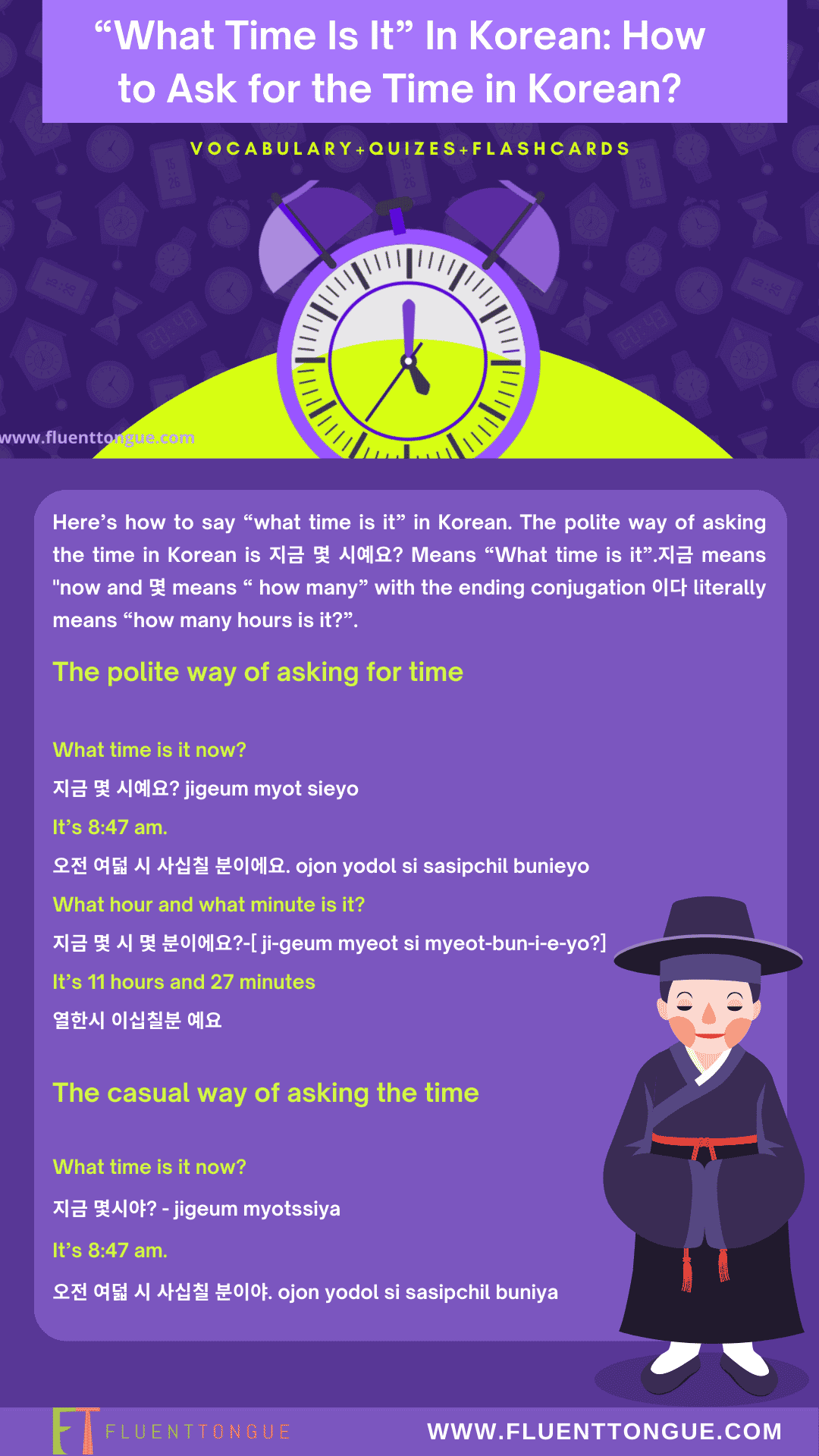
On your visit to Korea, you should be able to ask “What time is it in Korean?”.
Look at these phrases and just change the time as per the situation
and you are good to go.
Here’s how to say “what time is it” in Korean. The polite way of asking the time in Korean is “지금 몇 시예요” which means “What time is it”.지금 means “now and 몇 means “How many” with the ending conjugation 이다 literally meaning “How many hours is it?”.
Still confused? Here‘s how
The polite way of asking for time
- What time is it now?
지금 몇 시예요? jigeum myot sieyo
- It’s 8:47 am.
오전 여덟 시 사십칠 분이에요. ojon yodol si sasipchil bunieyo
- What hour and what minute is it?
지금 몇 시 몇 분이에요?-[ ji-geum myeot si myeot-bun-i-e-yo?]
- It’s 11 hours and 27 minutes
열한시 이십칠분 예요
The casual way of asking the time
However, you can use 지금 몇시야 ? in case of younger people and someone you know well or younger than you. but if you are confused, 지금 몇 시예요? can be your scapegoat.
- What time is it now?
지금 몇시야? – jigeum myotssiya
- It’s 8:47 am.
오전 여덟 시 사십칠 분이야. ojon yodol si sasipchil buniya
Other common Korean phrases to ask for time
- What time shall we meet?
몇시에 만날까요?[myeot-si-e man-nal-kka-yo?]
Let’s meet at 7 o’clock.
일곱 시에 만나요.
- What time do you wake up?
몇시에 일어 나세요?[myeot-si-e il-eo na-seo-yo?]
I get up at 6 o’clock.
여섯 시에 일어나요.
- What time do you go to bed?
몇시에 주무세요?[myeot-si-e ju-mu-se-yo?]
- What time do you go to work?
몇시에 일하러 가세요?[myeot-si-e il-ha-reo ga-se-yo?]
- When does the bus arrive?
언제 버스가 도착해요?
I arrived at 10:30.
열 시 삼십 분에 도착했어요.
Done with this. — What next?
Concept of time in Korea: Does Korea use a 24-hour clock or a 12-hour clock?
Both the 12-hour and 24-hour clocks are used in Korea.
The question is when to use each one
When to use 24 hr clock
The 12-hour clock is predominantly used in informal daily life, Koreans usually use the 24-hour clock in TV schedules, bus schedules, railway timetables, plane departure, and landing timings.
In fact, in movie theaters, it’s not uncommon to see something like 23:30 for the 11:30 p.m. movie
How to use 24 hr clock
Remember to use Sino Korean numbers while telling time in Korean using a 24-hour clock. In fact the hours also, you should use Sino Korean numbers only.
It starts from 00:00 to 23:59. How do Koreans normally call times in this system, then?
To Tell time in Korean Using the 24-hour system, say the hours from 1 to 12 with pure Korean/Sino-Korean numbers, and for the rest, you can use Sino-Korean. 0 is read as “공” in this.
The structure will be like this
Hours(Sino-Korean) +시(si) + minutes (sino-Korean) + 분 (bun)
For example,
02:22 — “한 시 이십일 분” or “공한 시 이십일 분” or “공일 시 이십일 분”
03:05 — “세 시 사 분” or “공세 시 공사 분” or “공삼 시 공사 분”
07:55 — “아홉 시 오십오 분” or “공구 시 오십오 분”
Normally, hour numbers from five are not read like “공다섯”, “공여섯”, etc. Also, like those above, hours after 12 are called in Sino-Korean numbers.
14:05 — “십삼 시 일 분” or “십삼 시 공일 분”
13:30 — “십오 시 삼십 분” or “십오 시 반”
16:27 — “십육 시 이십 분”
22:45 — “이십이 시 십오 분”
00:02 — “공공 시 일 분” or “공공 시 공일 분”
20:35 – 이십이 시 십오 분
21:00 – 이십이 시 십오 분
23:23 – 이십이 시 십오 분
Thus, if we list all hour numbers from 0 to 24, then it’s like this:
- 00: 공공 시
- 01: 한 시, 공한 시, 공일 시
- 02: 두 시, 공두 시, 공이 시
- 03: 세 시, 공세 시, 공삼 시
- 04: 네 시, 공네 시, 공사 시
- 05: 다섯 시, 공오 시
- 06: 여섯 시, 공육 시 [koŋnjuk̚ ɕi]
- 07: 일곱 시, 공칠 시
- 08: 여덟 시, 공팔 시
- 09: 아홉 시, 공구 시
- 10: 열 시, 십 시
- 11: 열한 시, 십일 시
- 12: 열두 시, 십이 시
- 13: 십삼 시
- 14: 십사 시
- 15: 십오 시
- 16: 십육 시
- 17: 십칠 시
- 18: 십팔 시
- 19: 십구 시
- 20: 이십 시
- 21: 이십일 시
- 22: 이십이 시
- 23: 이십삼 시
- 24: 이십사 시
How To Tell The Time In Korean Using A.M And P.M?

Confused about how to tell me in Korean with AM or PM in it?
Not anymore
Here’s how Korean use AM or PM with time and you can do it too
AM in Korean is called 오전(ojeon) which literally means “morning” and PM in Korean is called 오후(ohu) means evening.
There is another word for morning called 아침(Achim). The difference between 오전(ojeon) and 아침(Achim) is that ,오전(ojeon) indicates early morning to 12 o’clock and when you are talking about early morning breakfast time, going to work, you can use 아침(Achim).
To say TIME with AM in Korean, all you have to do is add “ojeon” with an hour in Sino Korean followed by(시)si and add minutes /seconds in Sino Korean and add the 분 (bun)/Cho next to it.
Here’s the exact structure
AM(오전[ojeon])+ Hours(Sino-Korean) +(시) si + minutes (sino-Korean) + 분 (bun)
- 1 am – 오전 한 시 (ojeon hanshi) – 오전(am)+ 한(1) +(시) si
- 2 am – 오전 두 시 (ojeon dooshi) – 오전(am)+ 두(2) +(시) si
- 3 am – 오전 세 시(ojeon seshi) – 오전(am)+ 세(3) +(시) si
- 4 am – 오전 네 시(ojeon neshi) -오전(am)+ 네(4) +(시) si
- 5 am – 오전 다섯 시 (ojeon daseosshi) – 오전(am)+다섯(5) +(시) si
- 6 am – 오전 여섯 시 (ojeon yeoseosshi) – 오전(am)+ 여섯(6) +(시) si
- 7 am – 오전 일곱 시(ojeon ilgopshi) – 오전(am)+ 일곱(7) +(시) si
- 8 am – 오전 여덟 시(ojeon yeodulshi) – 오전(am)+ 여덟(8) +(시) si
- 9 am – 오전 아홉 시(ojeon ahopshi) – 오전(am)+ 아홉(9) +(시) si
- 10 am – 오전 열 시 (ojeon yeolshi) – 오전(am)+ 열(10) +(시) si
- 11 am – 오전 열한 시 (ojeon yeolhanshi) – 오전(am)+열한(11) +(시) si
- 12 am – 오전 열두 시(ojeon yeoldooshi) – 오전(am)+ 열두(12) +(시) si
To say PM in Korean, all you have to do is add put the word 오후[ohu]) in front and count hour in Sino Korean and(시) si next to it followed by minutes in Sino Korean and the 분 (bun)
Here’s the exact structure to tell pm in Korean
PM(오후[ohu])+ Hours(Sino-Korean) +(시) si + minutes (sino-Korean) +분 (bun)
- 1 pm – 오후 한 시 (ohu hanshi) – 오후(pm)+ 한(1) +(시) si
- 2 pm – 오후 두 시 (ohu dooshi) – 오후(pm)+ 두(2) +(시) si
- 3 pm – 오후 세 시(ohu seshi) – 오후(pm)+ 세(3) +(시) si
- 4 pm – 오후 네 시(ohu neshi) -오후(pm))+ 네(4) +(시) si
- 5 pm – 오후 다섯 시 (ohu daseosshi) – 오후(pm)+다섯(5) +(시) si
- 6 pm – 오후 여섯 시 (ohu yeoseosshi) – 오후(pm)+ 여섯(6) +(시) si
- 7 pm – 오후 일곱 시(ohu ilgopshi) – 오후(pm))+ 일곱(7) +(시) si
- 8 pm – 오후 여덟 시(ohu yeodulshi) – 오후(pm)+ 여덟(8) +(시) si
- 9 pm – 오후 아홉 시(ohu ahopshi) – 오후(pm)+ 아홉(9) +(시) si
- 10 pm – 오후 열 시 (ohu yeolshi) – 오후(pm)+ 열(10) +(시) si
- 11 pm – 오후 열한 시 (ohu yeolhanshi) – 오후(pm)+열한(11) +(시) si
- 12 pm – 오후 열두 시(ohu yeoldooshi) – 오후(pm)+ 열두(12) +(시) si
Let’s take some examples
- 12:13 pm = 오후 열둘 시 십삼분 (ohu hanshi) – 오후(pm)+ 열둘(12) +(시) si+십삼(13)+ 분(bun)
- 7:58 am = 오전 일곱 시오십팔분 (ojeon dooshi) – 오전(am)+ 일곱(7) +(시) si
- 1:27 am = 오전 일곱 시이십칠분 (ojeon dooshi) – 오전(am)+ 두(1) +(시) si
- 3:48 am = 오전 세시사십팔분 (ojeon dooshi) – 오전(am)+ 두(3) +(시) si
- 1:53pm = 오후 한 시 오십삼분 (ohu hanshi) – 오후(pm)+ 열둘(1) +(시) si+십삼(13)+ 분(bun)
Example sentences
- Minho, pick me up at the airport at 3 p.m
민호야, 오후 세 시에 공항으로 데리러 와.
minhoya ohu se sie gonghangeuro deriro wa
- We had tea and biscuits at 7:30 PM
우리는 오후 일곱 시 반에 차와 비스킷을 먹었어
urineun ohu ilgop si bane chawa biseukiseul mogosso
- My appointment is at 2pm.
약속은 오후 두시에요- yakssogeun ohu dusieyo
- Our business hours are from 8 a.m. to 5 p.m
영업시간은 오전 여덟시부터 오후 다섯시까지입니다.
yongopssiganeun ojon yodolssibuto ohu dasotssikkajiimnida
- I will see you at 9 a.m
오전 아홉시에 만나요 – ojon ahopssie mannayo
- The supermarket is open until 8 p.m.
슈퍼마켓은 오후 8시까지 영업하요.
syupomakeseun ohu pal sikkaji yongopayo
- My alarm went off at 6 A.M.
아침 6시에 알람이 울려서. – achim yuk sie alrami ulryoso
- Our school starts at 9 a.m. and ends at 3:30 p.m.
우리 학교는 오전 아홉시에 시작해서 오후 세 시 반에 끝나요.
uri hakkkyoneun ojon ahopssie sijakaeso ohu se si bane kkeunnayo
so what’s next?
it’s time for some time for Korean quiz:

Test yourself on telling the time in Korean.
Try writing or saying these times in Korean, both in hangul and romanization without looking at the answers first.
- 6:13 am-
- 1:30 pm
- 12:06 pm
- 11:09 am
- 6:49 pm
Answer- 1.여섯시십삼분 2.한 시반 3.열두 시육분 4.열한 시구분 5. 여섯 시사십구분
Wanna get more detailed than AM or PM?
Here you go
How to indicate a certain time of day in Korean?

In English we also creatively express the time by using phrases like it’s 15 minutes past the hour, 10 in the morning or it’s 45 minutes before 11 in the morning.
Korea is no different.
You can also choose to say a time of the day instead of 오후 or 오전. You place it the same way but you use a time like 아침 (morning) or 새벽 (dawn).
Here are some more times of the day that might come in handy.
Let’s take a look!
- Morning in Korean – 아침(achim)-hours between 7 am to 11 am.
- Evening in Korean – 저녁 (juhnyeok)- hours between 6 pm to 11 pm.
- Noon in Korean – 정오(jeong-o)
- Dawn in Korean – 새벽 (sebyeok) – hours between 1 am to 6 am.
- Dusk in Korean – 황혼[hwanghon]
- Night in Korean – 밤 (bam)
- Afternoon in Korean – 오후(ohu)
Dawn in Korean is called 새벽 (sebyeok). You can use this word to indicate the hours between 1 am to 6 am.
- 1 at dawn = 새벽 한 시(sebyeok hanshi) = 새벽(sebyeok) +한(1) +시(si)
- 2 at dawn = 새벽 두 시(sebyeok dooshi) = 새벽(sebyeok) +두(2) +시(si)
- 3 at dawn = 새벽 세 시(sebyeok seshi) =새벽(sebyeok) +세(3)+ 시(si)
- 4 at dawn = 새벽 네 시(sebyeok neshi) = 새벽(sebyeok)+ 네(4)+ 시(si)
- 5 at dawn = 새벽 다섯 시(sebyeok daseosshi) = 새벽(sebyeok)+ 다섯(5)+ 시(si)
- 6 at dawn = 새벽 여섯 시(sebyeok yeoseosshi) = 새벽(sebyeok)+ 여섯(6)+ 시(si)
Koreans use 아침 (achim) means “morning” for hours between 7 am to 11 am.
- 7 in the morning = 아침 일곱 시(achim ilgopshi) = 아침(achim) +일곱(7)+시(si)
- 8 in the morning = 아침 여덟 시(achim yeodulshi) = 아침(achim)+ 여덟(8) +시(si)
- 9 in the morning = 아침 아홉 시(achim ahopshi) = 아침(achim) +아홉(9)+ 시(si)
- 10 in the morning = 아침 열 시(achim yeolshi) = 아침(achim)+ 열+(10) +시(si)
- 11 in the morning = 아침 열한 시(achim yeolhanshi) = 아침(achim)+ 열한(11)+ 시(si)
저녁 (juhnyeok), which means “evening. you can use 저녁 (juhnyeok) to indicate hours between 6 pm to 11 pm.
- 6 in the evening = 저녁 여섯 시(juhnyeok yeoseosshi) = 저녁((juhnyeok)+ 여섯(6)+ 시(si)
- 7 in the evening = 저녁 일곱 시(juhnyeok ilgopshi) = 저녁((juhnyeok)+ 일곱(7) +시(si)
- 8 in the evening = 저녁 여덟 시(juhnyeok yeodulshi) = 저녁((juhnyeok)+ 여덟(8)+시(si)
- 9 in the evening = 저녁 아홉 시(juhnyeok ahopshi) = 저녁((juhnyeok)+ 아홉(9) +시(si)
- 10 in the evening = 저녁 열 시 (juhnyeok yeolshi) = 저녁((juhnyeok)+ 열 (10)+시(si)
- 11 in the evening = 저녁 열한 시(juhnyeok yeolhanshi) = 저녁((juhnyeok)+ 열한(11) +시(si)
And instead of JUHNYEOK, you can also use 밤 (bam) for “night.”
- 6 at night = 밤 여섯 시(bam yeoseosshi) =밤 (bam)+여섯(6) +시(si)
- 7 at night = 밤 일곱 시(bam ilgopshi) = 밤 (bam)+ 일곱(7) +시(si)
- 8 at night = 밤 여덟 시(bam yeodulshi) =밤 (bam)+ 여덟(8) +시(si)
- 9 at night = 밤 아홉 시(bam ahopshi) = 밤 (bam)+ 아홉(9) +시(si)
- 10 at night = 밤 열 시(bam yeolshi) = 밤 (bam)+ 열(10) +시(si)
- 11 at night = 밤 열한 시(bam yeolhanshi) = 밤 (bam)+ 열한(11)+시(si)
- 12 at night = 밤 열두 시(bam yeoldooshi) = 밤 (bam)+ 열두(12) +시(si)
Not too complicated, is it?
Example sentences
- We’re going to the movies at seven o’clock in the evening
“우리는 저녁 일곱 시에 영화를 보러 갈 거예요.”
urineun jonyok ilgop sie yonghwareul boro gal goeyo
- I usually shower at 7 in the morning
나는 주로 아침 7시에 샤워해요
naneun juro achim chil sie syawohaeyo
- I had kimchi stew at 6 in the evening
어제 저녁 여섯시에 김치찌개를 먹었어요
oje jonyok yosotssie gimchijjigaereul mogossoyo
- I arrived in Korea at 11 p.m.
나는 밤 열한 에 한국에 도착했어요
naneun bam yolhan e hanguge dochakaessoyo
- He works until midnight and sleeps during the day.
그는 밤 12시까지 일하고 낮에 잔다..
geuneun bam sibi sikkaji ilhago naje janda
- This drama airs at 8pm, right?
이 드라마는 저녁 여덟 시에 하는 거죠?
i deuramaneun jonyok yodol sie haneun gojyo
- I don’t like going out alone after ten o’clock at night.
밤 열 시이후에 혼자 나가는 걸 좋아하지 않는다.
bam yol siihue honja naganeun gol joahaji anneunda
- We started in 6 in the morning, and ended at 7 in the evening
아침 6시에 시작해서 저녁 7시에 끝났어요.
achim yuk sie sijakaeso jonyok chil sie kkeunnassoyo
Learning about telling time in Korean, along with days of the week and date in Korean isa must-have,if you want to improve your conversation skills.
Well, you never know when dates and days can pop up in a conversation when you are talking about time.
Also, knowing the right way of telling dates in Korean can help you avoid misunderstandings.
How To Tell The Duration OF TIME In Korean (2 Hours/2minutes Etc…)?
Sometimes you want to say something like, “I have done things for X hours”/duration(instead of exact time) like “I ate three hours ago or I slept for 9 hrs”.
Well, it’s time to learn how to count time in Korean
Here’s how
When talking about hours you can use the counter 시 but the word 시간 is used when counting hours. 시간 means “time” in Korean.
Here’s the basic structure
Native korean number + 시간(sigan)
Let’s see explain the difference between the 시(si) and 시간(sigan) with examples
- 4 o’clock- 세 시 (se sigan)
- for four hours = 세 시간 동안 (se sigan dongan)
- 17 hours – 열일곱시간 ( yorilgopssigan)
- For 17 hours – 열일곱시간 동안 (yorilgopssigan dongan)
- 10 minutes – 십분(sipppun)
- For 10 minutes – 십분 동안(sipppun dongan)
- 32 seconds – 삼십이분 samsibibun
- For 32 seconds – 삼십이분 동안 (samsibibun dongan)
- For two hours, twenty minutes and five seconds in korean – “두 시간 이십분 오초 동안 du sigan isipppun ocho dongan
For example
- I only slept for 5 hours yesterday.
저는 어제 다섯 시간 동안 잤어요-joneun oje dasot sigan dongan jassoyo
- I watched the drama for 1 hour
나는 드라마를 한 시간 동안 봤어요.-naneun deuramareul han sigan dongan bwassoyo
- I take a break for 10 minutes.
십분 동안 휴식을 취해요- sipppun dongan hyusigeul chwihaeyo
- I drove for 3 hours
나는 오늘 세 시간 동안 운전을 했어요.-naneun oneul se sigan dongan unjoneul haessoyo
- I met Suzy for 50 seconds.
수지를 오십초 동안 만났어요.sujireul osip cho dongan mannassoyo
35 Popular Adverbs About Time In Korean For Beginners.
Koreans use adverbs of time, place, mode, or quantity all the time.
You’ll quickly become very familiar with them as they’re commonly used in real-life conversations.
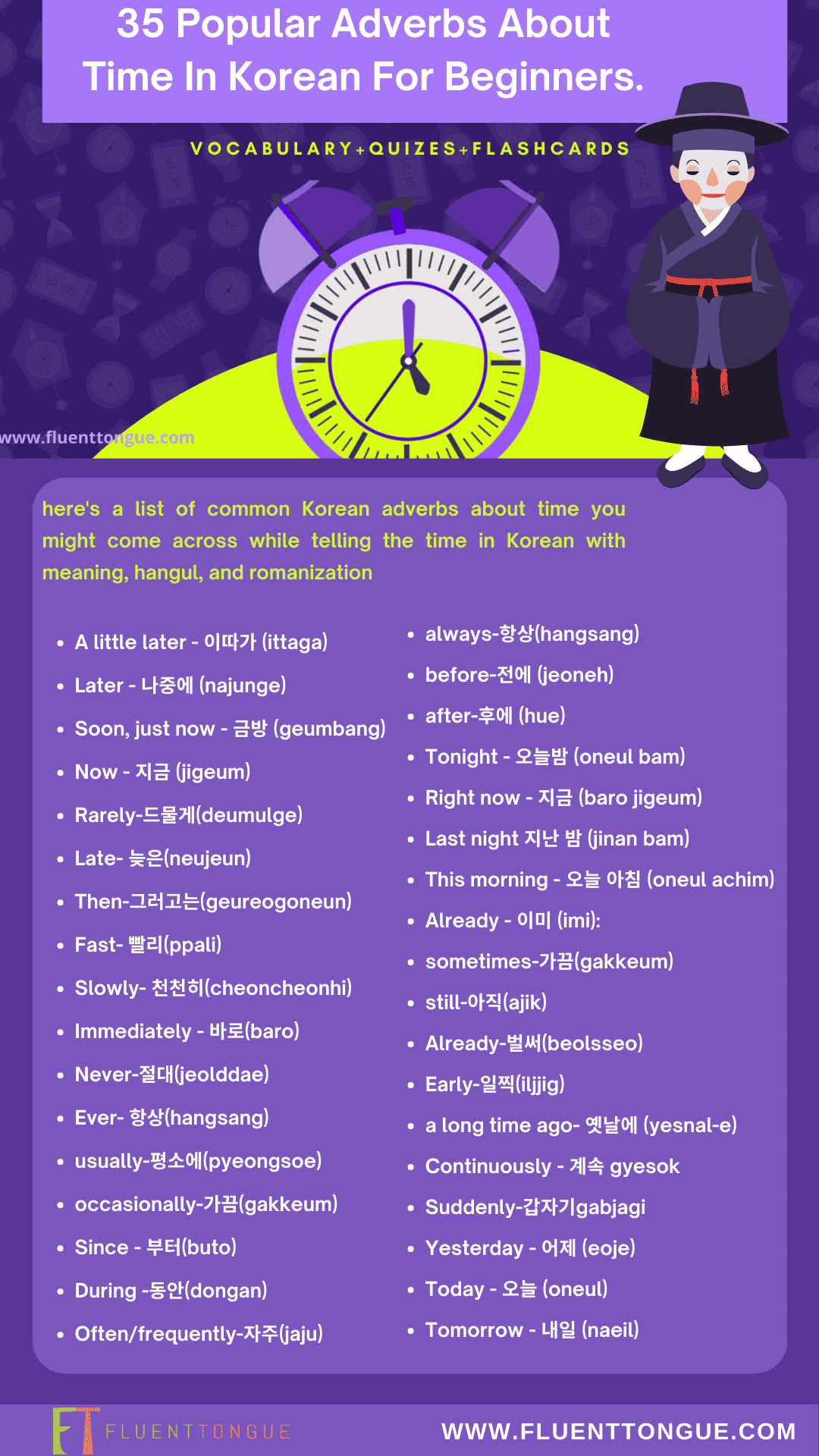
Here’s a list of common Korean adverbs about time you might come across while telling the time in Korean with meaning, hangul, and romanization
- A little later – 이따가 (ittaga)
- Later – 나중에 (najunge)
- Soon, just now – 금방 (geumbang)
- Now – 지금 (jigeum)
- Rarely-드물게(deumulge)
- Late- 늦은(neujeun)
- Then-그러고는(geureogoneun)
- Fast- 빨리(ppali)
- Slowly- 천천히(cheoncheonhi)
- Immediately – 바로(baro)
- Never-절대(jeolddae)
- Ever- 항상(hangsang)
- usually-평소에(pyeongsoe)
- occasionally-가끔(gakkeum)
- Since – 부터(buto)
- During -동안(dongan)
- Often/frequently-자주(jaju)
- always-항상(hangsang)
- before-전에 (jeoneh)
- after-후에 (hue)
- Tonight – 오늘밤 (oneul bam) :
- Right now/currently – 지금 (baro jigeum):
- Last night 지난 밤 (jinan bam):
- This morning – 오늘 아침 (oneul achim)
- Already – 이미 (imi):
- sometimes-가끔(gakkeum)
- still-아직(ajik)
- Already-벌써(beolsseo)
- Early-일찍(iljjig)
- In the old days/ a long time ago- 옛날에 (yesnal-e)
- Continuously – 계속 gyesok
- Suddenly-갑자기gabjagi
- Yesterday – 어제 (eoje)
- Today – 오늘 (oneul)
- Tomorrow – 내일 (naeil)
Example sentences
- I will eat later
이따가 먹을게요 – ittaga mogeulkkeyo
- I will text you later.
내가 이따가 문자 보낼게요.- naega ittaga munja bonaelkkeyo
- I just woke up
방금 일어 났어 – bang-geum il-eo nass-eo
- I used to hate coffee in old days
옛날에는 커피를 싫어했어요.-yennareneun kopireul sirohaessoyo
- My mum is rarely busy.
우리 엄마는 거의 바쁘지 않아요.-uri ommaneun goi bappeuji anayo
- My dad is sometimes home early from work.
아빠는 가끔 일찍 퇴근하셔서 집에 오십니다
- I frequently go to the cinema.
우리는 자주 영화관에 간다.-urineun jaju yonghwagwane ganda
- Are you still going to the party?
아직도 파티에 갈 거예요?-ajiktto patie gal goeyo
How to use the Time particle 에 (e) in Korean

If you want to say that something is happening at a certain time, we can use the Korean particle 에 (e) is used. It means literally “at”
Example:
- I usually leave work at 8:30
나는 보통 여덟시 반에 퇴근한다- naneun botong yodolssi bane twegeunhanda
- What time did you get home last night?
어젯밤에 집에 몇 시에 왔니? – ojetppame jibe myot sie wanni
- I came home in a week
일주일 만에 집에 왔어요. – iljuil mane jibe wassoyo
- Go to bed at 10. Get up at 8.
열시에 자서 일곱시에 일어 – yolssie jaso ilgopssie iro
- Sister, Should I go home at 5 o’clock?
누나 다섯시에 집에 갈까? – nuna dasotssie jibe galkka
- Let’s meet at 9 o’clock
아홉시에 만나자.- ahopssie mannaja
36 Must-Have Time Words To Tell The Time In Korean Like Natives
The next very important step is to learn the vocabulary related to time.
These time words are commonly used and you never know when they will pop up in a conversation
It is always good to increase your Korean vocabulary list.
- Today—O-neul (Oh-nule)
- Yesterday—Eo-je (Oh-jay)
- The day before yesterday—Keu-jeo-kke (Koo-cho-kay)
- Tomorrow—Nae-il (Nay-eel)
- This week—I-beon-ju (Ee-bone-chu)
- Last week—Chi-nan-ju (Chee-nan-chu)
- Next week—Ta-eum-ju (Tah-reum-chu)
- For one week—Il-ju-il-gan (Eel-chu-eel-gan)
- For two weeks—I-ju-il-gan (Ee-chu-eel-gan)
- For one day—Ha-ru (Hah-roo)
- For two days—I-teul-gan (Eet-tule-gan)
- Three days ago—Sam-il-cheon (Sam-eel-chone)
- Four months ago—Sa-gae-weol-cheon (Sah-gay-wole-chone)
- Five years ago—O-nyeon-cheon (Oh-neeyone-chone)
- This year—Keum-nyeon (Kume-neeyone)
- Last year—Chang-nyeon (Chang-neeyone)
- Next year—Nae-nyeon (Nay-neeyone)
- At night—Pam-e (Pahm-may)
- In summer—Yeo-reum-e (Yoh-rume-eh)
- In winter—Kyeo-u-re (Keeyo-oo-ray)
- By Tuesday—Hwa-yo-il-ka-ji (Hwah-yo-eel-kah-chee)
- By June—Yu-weol-il-ka-ji (Yoo-wole-eel-kah-chee)
- By Morning—A-chim-ka-ji (Ah-cheem-kah-chee)
- This morning—O-neul a-chim (Oh-nule Ah-cheem)
- This afternoon—O-neul o-hu (Oh-nule Oh-hoo)
- This evening—O-neul cheon-nyeok (Oh-nule chone-neeyoke)
- Tonight—O-neul-pam (Oh-nule-bahm)
- Tomorrow night—Nae-il-pam (Nay-eel-bahm)
- For six years—Yung-nyeon-gan (Yung-neeyone-gahn)
- For seven months—Chil-gae-weol-gan (Cheel-gay-wole-gahn)
- In the morning—A-chim-e (Ah-cheem-may)
- In the afternoon—O-hu-e (Oh-hoo-eh)
- In the evening—Cheo-nyeok-e (Cho-neeyoke-eh)
- Overtime-야근(yageun)
- Night shift-야간 근무-yagan geunmu
- Day shift – 주간 근무 – jugan geunmu
Essential Time Expression For Beginners.
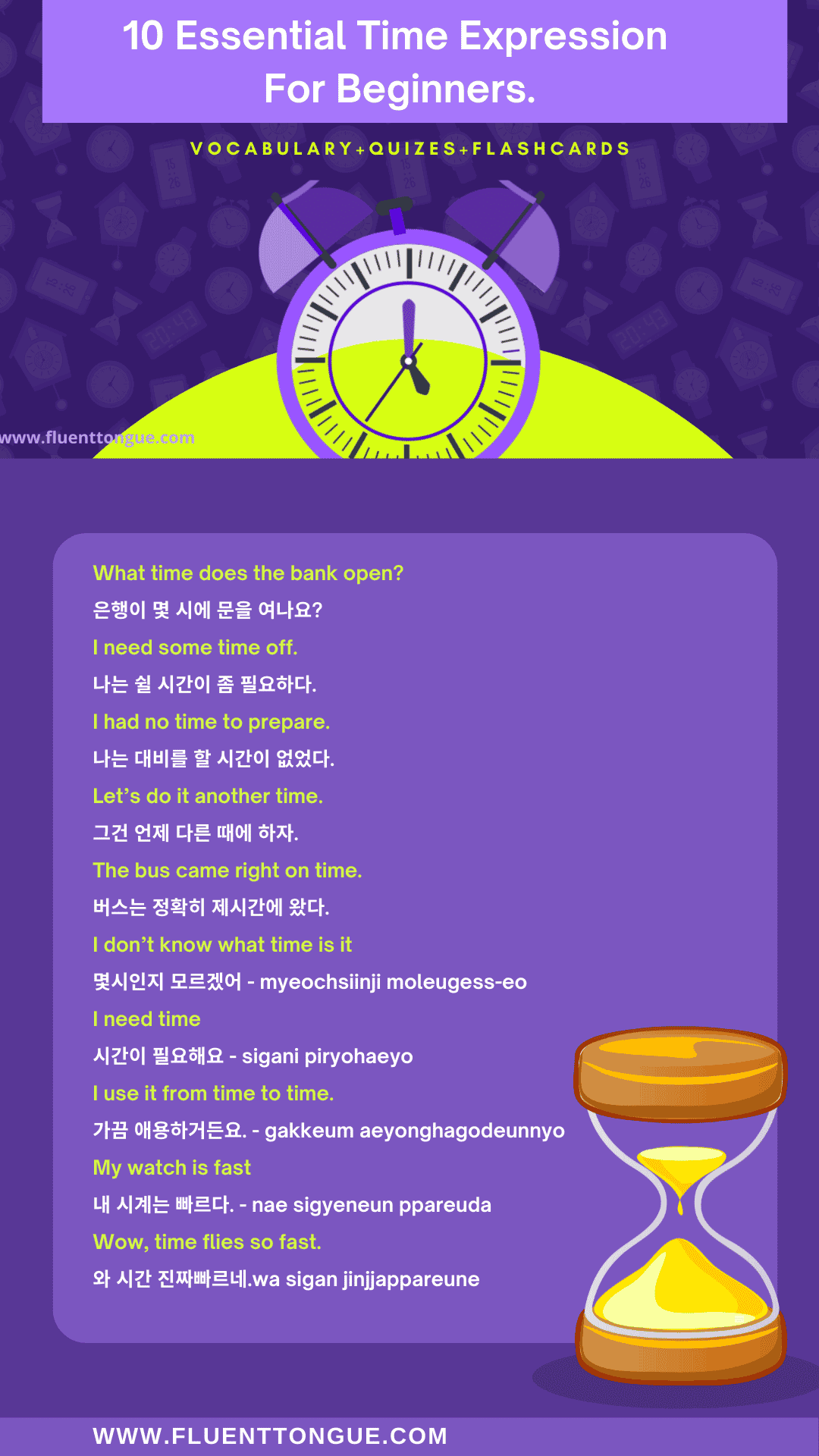
Wow. You can tell any time in Korean.
That’s great
Here’s something better
Let’s see how we can make some useful sentences.
Because knowing the basics is not enough. The key to fluency is practice in real-life situations
- What time does the bank open?
은행이 몇 시에 문을 여나요?
- I need some time off.
나는 쉴 시간이 좀 필요하다.
- I had no time to prepare.
나는 대비를 할 시간이 없었다.
- Let’s do it another time.
그건 언제 다른 때에 하자.
- The bus came right on time.
버스는 정확히 제시간에 왔다.
- I don’t know what time is it
몇시인지 모르겠어 – myeochsiinji moleugess-eo
- I need time
시간이 필요해요 – sigani piryohaeyo
- I use it from time to time.
가끔 애용하거든요. – gakkeum aeyonghagodeunnyo
- My watch is fast
내 시계는 빠르다. – nae sigyeneun ppareuda
- Wow, time flies so fast.
와 시간 진짜빠르네.wa sigan jinjjappareune
5 common Time Proverbs and Sayings in Korean you need to sound like a native.

If you want to sound like a native, idioms and expressions are the best tools.
However, the thing is that you know when and how to use them, or it can have the opposite effect!
Here are some common Korean phrases on time/time to help you sound like a native and show off your language skills.
- Time is money.
시간은 돈이다. – Siganeun donida.
- It’s the earliest when you think it’s too late/Better late than never.
늦었다고 생각할 때가 가장 빠르다.neujotttago saenggakal ttaega gajang ppareuda
- The early bird catches the worm.”
일찍 일어나는 새가 벌레를 잡는다.
Iljjik ireonaneun saega beollereul jamneunda.
- Time flies like an arrow.
시간이 쏜살같이 간다. – sigani ssonsalgachi ganda
- Time heals all wounds
시간이 약이다. – Sigani yagida.
How to remember the time in Korean quickly and never forget it?
See, I told you it’s easy to tell any time in Korean once you know the right way.
But when it comes to fluency, practice and more practice is the key
Here are some interesting resources I found while I was learning Korean. You can use this to practice telling time in Korean in different ways till it becomes your second nature.
So, let’s take a look
Anki Isn’t The Only Game In Town. sing a song
Did you know you can sing a song and master telling time in the Korean language?
Well, what could be better than that?
Here is how Koreans do it all the time (now you can do it too!!!)
if learning with Korean time song doesn’t suit you,
How about telling time with a Korean quiz?
Use flashcards and Test
Maybe mnemonics is not your thing. What about flashcards?
I know it’s an old thing(you might be using Anki too)
But When it comes to mastering Korean vocabulary, you will never regret using these fellas.
Here are some other great resources for flashcards I found while I was learning Korean online
Korean Vocabulary Quiz
Time Telling Practice in Korean
- https://www.purposegames.com/game/telling-time-in-Korean-for-chinese-learners
- https://quizizz.com/admin/quiz/60ee50782e3c7a001de56d6e/Korean-m5-unit-1-telling-time
Other Online Resources
We live in the era of the 20th century.
And I bet you love to surf (well, who doesn’t?)
The internet is full of free stuff and language resources that you haven’t explored yet. Here is what I found when I was learning.
Here is a list (I hope it might help you)
- https://www.wikihow.com/Count-to-10-in-Korean
- https://en.wikipedia.org/wiki/Date_and_time_notation_in_South_Korea
Conclusion and Korean Vocabulary Quiz
So, you’ve learned the basics of telling time in Korean. That’s great !!.
Let’s be happy that making plans and scheduling things will be a piece of cake after grasping this piece of information.
You may wish to focus on practicing telling time using this format until it feels natural to you before moving on.
Try looking at a clock at random times throughout the day
Even better
Practice by writing it out. Like “Class: 3 pm Tuesday” or “Work: 9 am in the morning ” Or Write Out Your Schedule in Korean!
The more you practice, the better you’ll get!
Korean Time Quiz: How well do you know how to tell the time in Korean.
Go ahead and judge yourselves with these times. Write down the answers and start practicing:
17.30, 20.15, 6.00, 8.10, 10.25, 12.35, 13.45, 16.50

